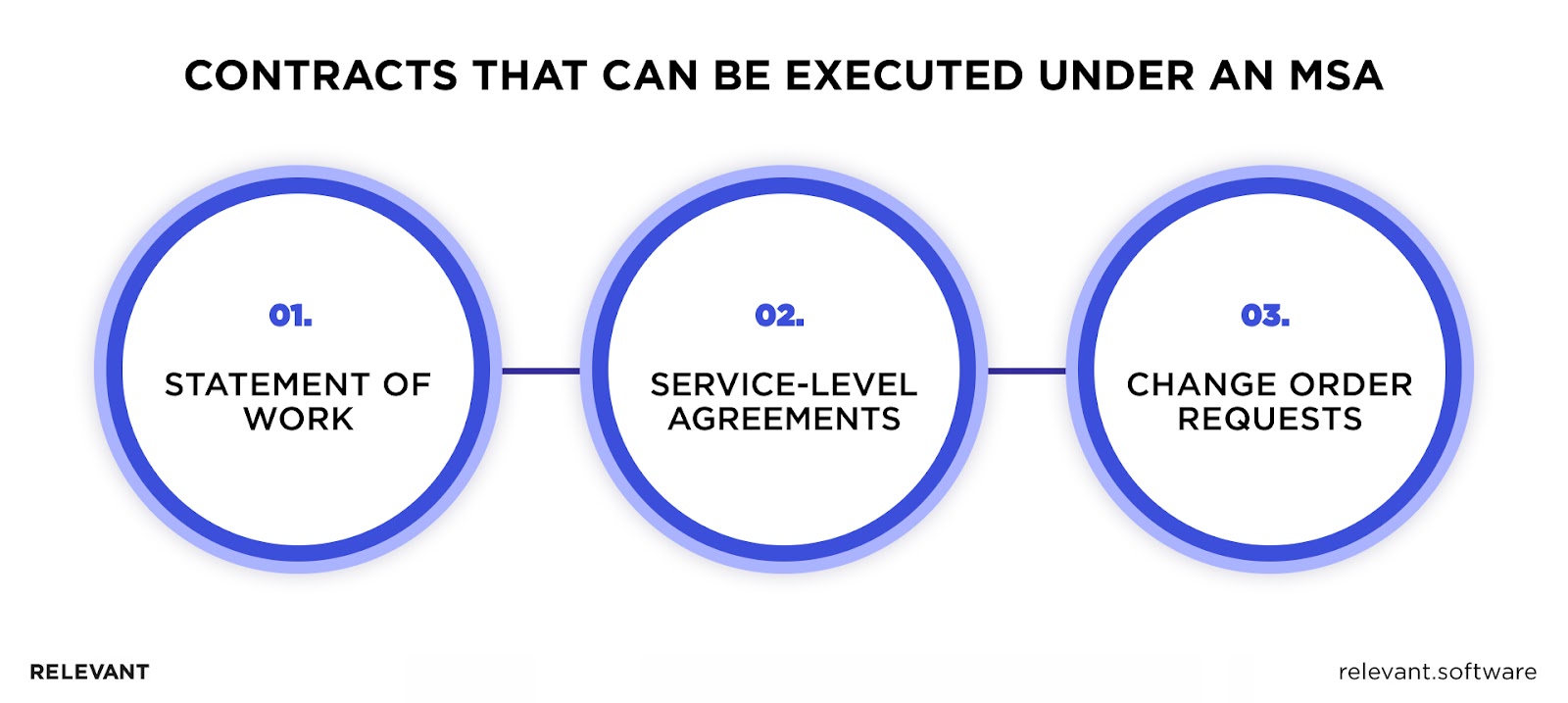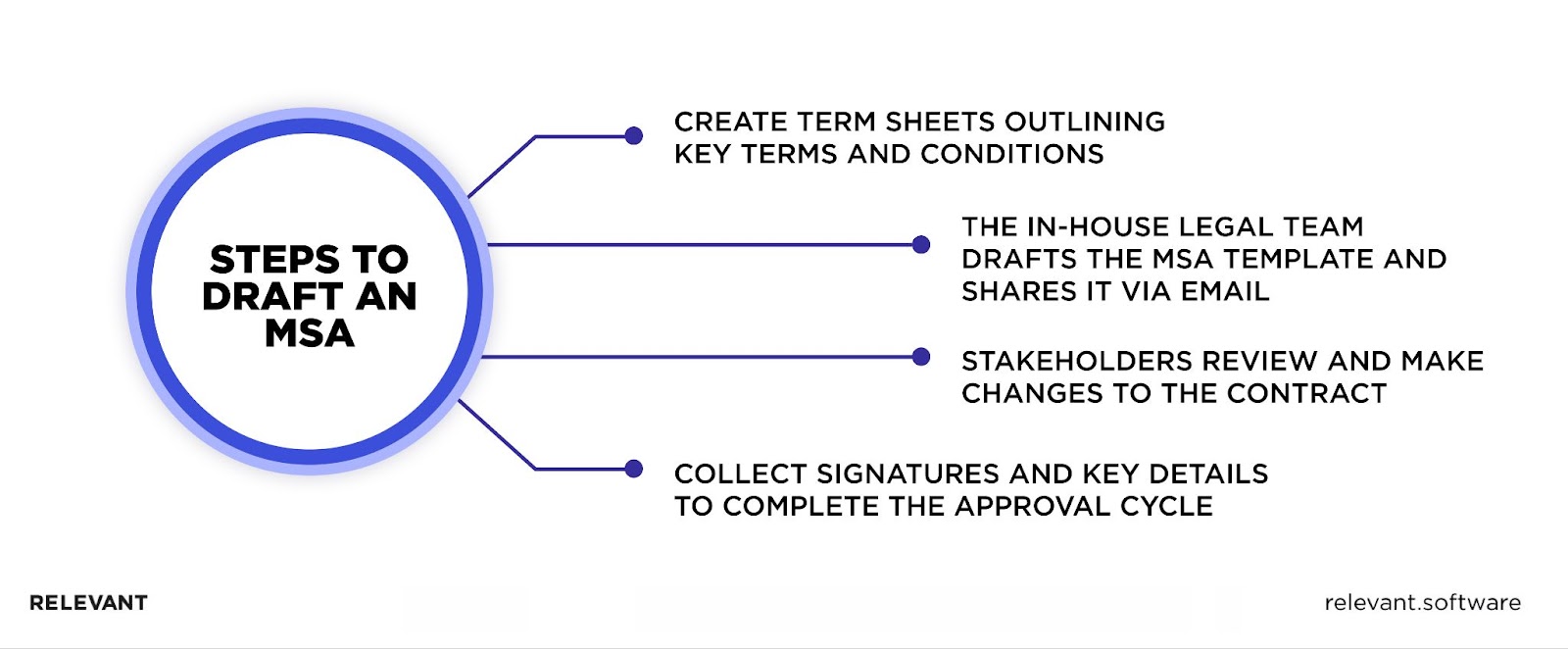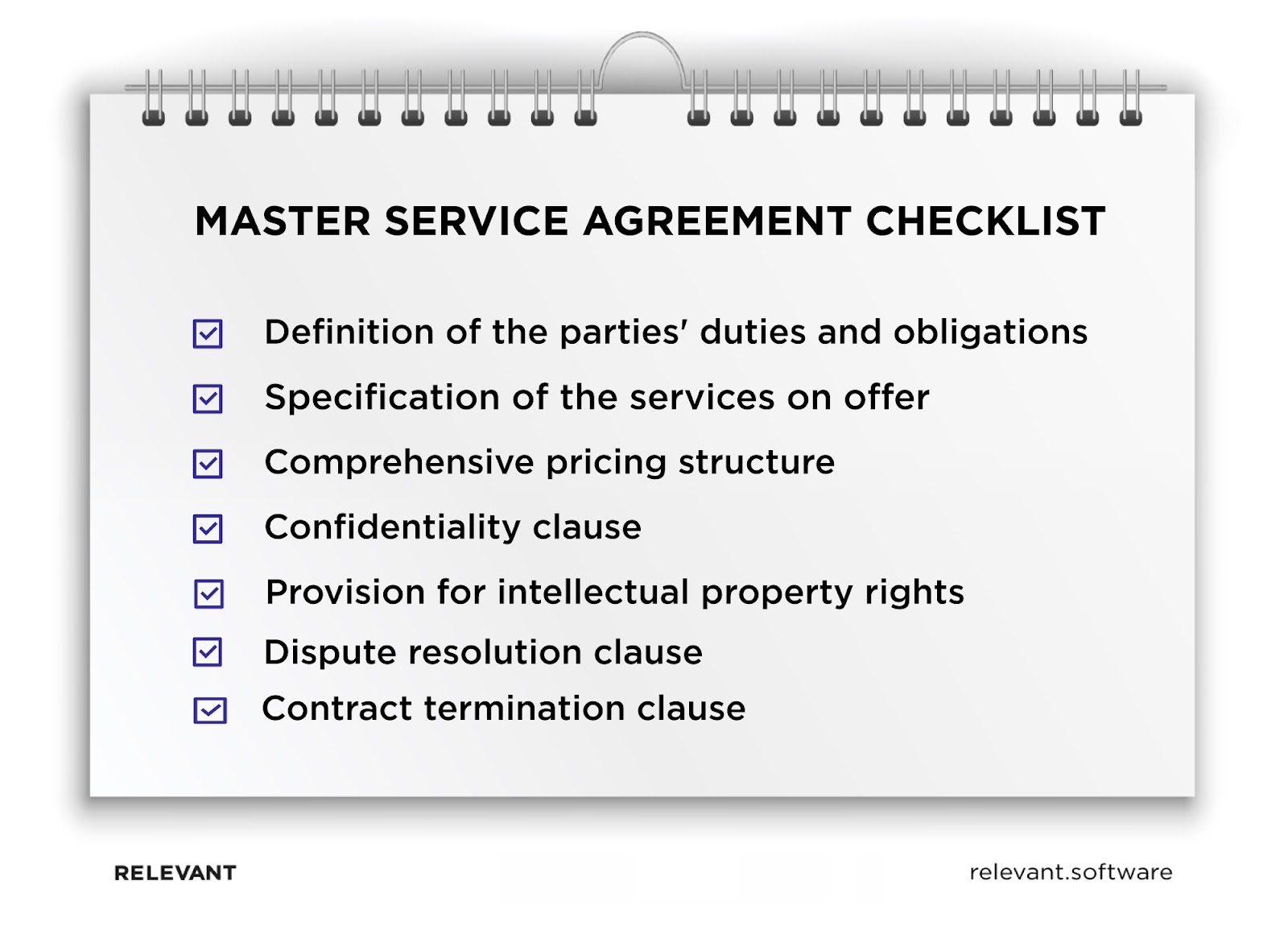The Ultimate Guide to Understanding Software Master Service Agreement
Updated: June 4, 2025
Embarking on an IT outsourcing project often entails a commitment that extends beyond the initial contract. Picture this: you’ve identified a proficient software product development company, their team of stellar developers has exceeded your expectations, and you’re eager to prolong this fruitful partnership. The MSA (Master Service Agreement) serves as the perfect solution to facilitate this continuity and simplify general contract regulations. An MSA becomes your ally in these circumstances, demystifying the development process through standard contract regulations for all your projects.
Moreover, an IT MSA allows you to bypass the red tape and the financial burden associated with creating new documentation for each venture. It’s your shortcut to efficient, long-term collaboration. The best part of an MSA is that it helps minimize legal expenses and bureaucracy. In this blog post, we’ll uncover the Master Services Agreement definition, its essential components, and reveal its vital role in the successful outsourcing of offshore software development. You’ll also find the IT Master Services Agreement template you can use for your software development outsourcing projects.

We provide companies with senior tech talent and product development expertise to build world-class software. Let's talk about how we can help you.
Contact usTable of Contents
Introduction to Master Service Agreement in Software Development
Engaging in contract negotiations can feel like wading through quicksand for clients and vendors. This process is not only incredibly time-consuming but can also be daunting, particularly when both parties anticipate an extended period of collaboration. In addition, each new project potentially leads to another wave of contract negotiations.
However, good news for those tired of contractual hassles is Master Service Agreements. These contracts are designed to ease the burden of time and expense, increasing the efficiency and productivity of working relationships.

An MSA in software development streamlines collaboration, fosters higher-level productivity, and, yes, it adds a newfound cohesion and satisfaction to the working relationship.
Would you like to discover how it can strengthen your company’s cooperation with IT providers? Or perhaps you’re interested in how to outsource your project successfully? Then, keep reading to discover it. But first, let’s find out what is a Master Services Agreement.
Defining the Software Master Services Agreement
In essence, a Master Service Agreement (MSA) is a contract for IT service provisions between two or more companies—namely, your enterprise and your chosen outsourcing partner. This document defines the regulatory landscape that navigates ongoing and forthcoming duties and actions. The MSA meticulously lays out project duties, roles, expectations, terms, service offerings, responsibilities, and other vital aspects of your partnership. Think of it as a roadmap, a guide, and a blueprint for successful, ongoing collaboration in software development. It takes the guesswork out of your cooperation, ensuring that both you and your vendor are perfectly aligned on every single detail.
So, how do Master Service Agreement IT services differ from other contracts, such as Non-Disclosure Agreements (NDA), Data Processing Agreements (DPA), and Statements of Work (SOW)? The answer lies in its core purpose. The MSA provides a framework that benefits both the IT service provider and the client, especially if they anticipate collaboration on multiple projects in the future. It enables seamless, recurring collaboration without repeatedly navigating through exhaustive paperwork and revisiting other agreement components. That’s what sets an IT MSA apart from more singular-focused agreements.
More than just administrative convenience, the MSA is an instrument of strategic business planning. It allows parties to proactively anticipate and adapt to any business landscape shifts, ensuring resilience in the face of unpredictability. Furthermore, emphasizing potential conflict areas or points of concern in advance, an MSA in software serves as a proactive measure for dispute resolution.

Importance of MSAs in IT Outsourcing
The Master Service Agreement is an essential instrument in the realm of IT Outsourcing. This document effectively streamlines the business process for companies and software vendors planning to engage in long-term collaborations. The beauty of MSA lies in its power to crystallize the workflow, eliminating the need for frequent renegotiations and approval of conditions that have already been established.
Beyond procedural simplification, an MSA agreement enables organizations to concentrate on the critical aspects of each project, such as objectives, goals, and timelines. It shifts the focus from paperwork to performance, from procedure to progress.
One of the significant advantages of a well-drafted MSA in IT outsourcing is its potential to circumvent contractual disputes and the specter of legal proceedings. It outlines the responsibilities of both parties for potential failures, unforeseen expenses, and intellectual harm, thus providing both parties with assurances and indemnities. In the event of a dispute, a comprehensively created MSA aids in swiftly identifying guilty parties, facilitating risk allocation and mitigation.
Given the importance and intricacy of this document, it’s no surprise if your next question might be…
Software Master Service Agreement – Who Provides It?
In software development, it’s common for the outsourcing vendor to write the IT Master Service Agreement. Why? Because software development providers have a better understanding and expertise in the nuances of the project’s development. That’s why a proficient outsourcing company is best placed to draw up an MSA and other important agreements as a part of a documentation package.
That’s not to say the client can’t write the MSA. They can, but it might take longer to review because the software company needs to check all the details. Outsourcing vendors have a lot of experience working with different companies and creating the right documents, so it’s often quicker and easier to let them do it.

For instance, at Relevant Software, we’ve worked with over 200 clients worldwide, providing them with all the necessary documents, including MSAs, NDAs, and SOWs.
Therefore, a seasoned software development company can draft the initial Master Service Agreement Software in a few days rather than weeks. The outsourcing firm’s expertise facilitates swift edits and adjustments to the document, speeding up the process of reaching mutual consent.
Key Components of a Master Service Agreement
An effective Master Service Agreement for IT services is like a roadmap, guiding both parties through the intricate details of their business relationship. It outlines financial safeguards, sets expectations, and ensures clarity, providing a beacon for project managers navigating the complexities of the project. For this purpose, an MSA in business should be carefully crafted and comprise such key sections.

Description of Services
Right after the introductory section, with the names, contact details, and official addresses of the parties involved, goes the most crucial part that sets the stage for the collaboration.
Here’s what you’ll usually find in the Provision of Services section:
- Main goals: What are the big-picture aims for future projects?
- Client expectations: What do you expect to achieve from this partnership?
- Services details: What specific services and tasks will the IT firm be doing under individual SOW?
- Change rules: What are the costs and procedures if SOW needs to be changed or adjusted?
- Progress reporting: How often will updates be shared on the progress of the work?
- Work model: What’s the standard work week look like, considering the time zone of the outsourcing company?
- Contractor guidelines: What are the rules about working with other contractors involved in the project?
- Independence guarantees: How will the IT company and the client maintain their independence?
This section makes sure both parties understand what’s being agreed to, paving the way for a successful partnership.
Performance Standards and Deadlines
In this section, you’ll find the performance benchmarks or quality standards the vendor must adhere to. These standards, often based on industry best practices, help you objectively measure the vendor’s performance, enabling you to evaluate if your project is meeting its defined goals effectively.
Deadlines are another aspect described in the IT MSA. Each project milestone will have a corresponding date attached to it. Deadlines keep the work focused, ensuring the timely delivery of each project phase. Sticking to these timelines is crucial to maintaining the project’s momentum and preventing delays from having a domino effect on subsequent stages of the project.
And obviously, this section should involve penalties for not meeting the agreed-upon standards or deadlines. This ensures that both parties understand the consequences of not meeting their obligations, providing an extra incentive to uphold their end of the agreement.
Lastly, this part of the MSA also sets the tone for communication expectations between you and the vendor. Regular status updates and reviews are generally included in this section, which helps foster transparency, holds both parties accountable, and provides opportunities for course corrections if needed.
Service-Level Agreements (SLAs)
The SLAs set the performance standards the IT outsourcing provider is expected to meet, creating clear service quality and responsiveness benchmarks. These agreements typically include critical performance metrics, such as uptime requirements, data backup frequency, and response time for service requests. These metrics allow the client to objectively assess the service quality and hold the provider accountable if performance falls below the agreed-upon standards.
Notably, SLAs aren’t merely a list of performance targets. They also outline the consequences of failing to meet these benchmarks. This might include penalties, remediation procedures, or even the right for the client to terminate the agreement in severe cases.
SLAs establish a mutual understanding of expectations between the client and the vendor. In addition, they provide a measure of predictability in the complex landscape of IT outsourcing, enabling a smoother, more productive partnership.
Payment Terms and Conditions
This section outlines how payments will be made and received, making it clear to both parties. In software development, there are typically three main methods of payment:

- Fixed price method. It works best for projects where the plan is detailed, and the delivery dates are known in advance. Payments are usually tied to completed tasks, milestones, or phases or could be made as a lump sum once the client accepts the product.
- Time and Materials (T&M). This method is suited to projects with a flexible scope where the exact requirements aren’t known upfront. Here, the client pays for the actual hours spent on the work as well as the cost of materials used.
- Dedicated team model. This method is ideal for larger, more complex projects where the client can hire a dedicated development team and effectively manage it. The client pays each month based on the hours each developer puts into the project.
In addition, this section will spell out how the client can accept or reject the work done and how they can request revisions. It will also detail how fees, taxes, and any unplanned expenses will be handled, as well as the method of payment transfer.
Read also on how to extend the software team.
Confidentiality and Intellectual Property Rights
Protecting data that becomes accessible during the collaboration is paramount, and the agreement should clearly state what information is considered confidential and not subject to public disclosure or exposure to third parties. It may include proprietary business strategies, internal workings, customer data, project details, and so on. The MSA for software development should also specify if the IT service provider can publicly mention their association with the client, such as in their marketing materials or case studies.
This section also outlines ownership rights to the products or services created during the contractual period. The agreement establishes who owns the copyright, patents, and all other intellectual property rights related to the project outcomes. This typically includes the work produced under individual SOWs.
Change management and escalation procedures
The IT Master Service Agreement often includes a framework for dealing with changes and solving problems. While individual projects typically detail specific involvement and monitoring measures in separate Statements of Work (SOW), the MSA outlines the overall managemental structure of software development and the general plan for managing changes and addressing issues in the software development process.
The part of the MSA about change management explains how to propose, approve, and carry out changes in the project’s scope, timelines, or resources. Having this transparent process in place, all parties understand how to adapt to changes while keeping the project running smoothly. This understanding is critical to allowing the project to change and grow in response to new business needs or market trends.
The section on escalation procedures provides a step-by-step guide for highlighting and fixing problems that can’t be solved at the everyday operational level. It outlines who should be contacted when an issue arises and how quickly they should respond, ensuring serious problems are promptly handled by the right people. This well-defined path is crucial to keeping the project on track and quickly resolving any potential disagreements or conflicts.
Companies might also create a Management Guide attachment to explain their administrative roles further. By doing so, the parties will promote clear communication and improved project management.
Termination and dispute resolution
Although each project within the larger framework has its specified timeframes and deadlines, the IT MSA, however, states the duration of the developer’s and client’s partnership. This means it details the overall duration of your MSA agreement with the software vendor and sets forth provisions for a software development contract extension, should you wish to extend the working relationship beyond the original term.
Equally important in this section is the detail around termination. The agreement details the circumstances that would allow for early termination by either party. These could range from a breach of contract, insolvency, or non-performance to even more specific causes unique to your arrangement. The termination clause also lays out the notice period required and the method for serving such notice, allowing for an orderly exit strategy.
The MSA also houses the dispute resolution clause, which includes procedures for escalating any issues that might arise during the project, from informal discussions right up to formal arbitration or litigation. It aims to ensure disputes are resolved fairly, timely, and cost-effectively.
Lastly, this section could potentially feature an automatic renewal procedure. This is particularly useful in long-term collaborations, permitting an effortless continuation of the agreement, provided both parties are in accord.
Best Practices for Managing an MSA
MSAs are at the heart of successful long-term collaborations when you plan to engage with a software development company. The agreement ensures a smooth process by setting clear terms and conditions, aligning expectations, and establishing guidelines for dispute resolution. But for an IT Master Services Agreement to truly succeed, it’s not enough to simply draft and sign it. Active management and engagement from both parties are crucial to successfully executing the MSA. So, here are some tips for managing it effectively:

- Understand your business needs. Begin by evaluating your business requirements, desired project outcomes, and the level of service you expect from your software vendor. This clear understanding is the bedrock of a successful MSA.
- Ensure clarity in the documentation. Make sure that the MSA, and all related documents, are clear and comprehensive. Every term, condition, and clause should be explicitly defined to eliminate ambiguity.
- Set regular communication. Foster an environment of open and frequent communication with your vendor. This ensures both parties are aligned in terms of expectations and responsibilities, reducing the chance of misunderstandings or disputes.
- Embrace proactive change management. Incorporate a well-defined change management process in your IT MSA. It should outline the steps for making changes to the MSA agreement or any individual projects, ensuring adaptability in the face of evolving business needs.
- Perform regular MSA reviews. Back to the agreement from time to time to verify it remains suitable for your changing business landscape. This ensures that the MSA is updated, relevant, and continues to add value.
- Seek legal consultation. Engage a legal expert familiar with software development contracts to review your MSA. This will help protect your interests and comply with applicable laws and regulations.
- Focus on long-term success. MSAs should be created with a long-term strategic outlook. Including provisions for growth and adjustments ensures it will continue to serve your needs as your business evolves.
- Establish clear dispute resolution processes. This will help you manage any disagreements and minimize potential damage to your business relationship, allowing you to focus on project completion.
Master Services Agreement Template for Software Development
Here’s a software services agreement template to help guide you through drafting your own contract for IT outsourcing services or software development. Please remember that this is a simplified example and should not be used as a substitute for professional legal advice:
MASTER SERVICE AGREEMENT TEMPLATE
THIS AGREEMENT is entered into this ____ day of , by, and between ________, a corporation duly organized and existing under the laws of the ________ (hereinafter “Client”), and ________, a corporation duly organized and existing under the laws of the ________ (hereinafter “Vendor”).
1.0 SCOPE OF SERVICES
1.1 Services: The Vendor agrees to provide the Client with services (“Services”) as defined in the attached Schedule of Work (SOW).
1.2 Goals and Objectives: The overall goals and objectives for future projects will be outlined in the individual SOWs.
2.0 PERFORMANCE STANDARDS AND DEADLINES
2.1 Vendor will comply with all standards and deadlines stipulated in individual SOWs.
3.0 PAYMENT TERMS
3.1 Fees: As consideration for the services rendered by the Vendor, the Client agrees to pay the Vendor as described in each SOW.
4.0 CONFIDENTIALITY
4.1 Both parties agree to maintain the confidentiality of all proprietary information received during the term of this MSA Agreement.
5.0 INTELLECTUAL PROPERTY
5.1 Ownership of all products, services, processes, methodologies, and other intellectual property developed by the Vendor for the Client under this Agreement will be discussed and agreed upon in each SOW.
6.0 CHANGE MANAGEMENT AND ESCALATION PROCEDURES
6.1 Any change requests or disputes during the course of the project should follow the procedures outlined in the respective SOW.
7.0 TERMINATION AND DISPUTE RESOLUTION
7.1 Either party may terminate this Agreement or any SOW for any reason with ______ days’ notice.
8.0 GOVERNING LAW
8.1 This Agreement shall be governed by the laws of ________.
IN WITNESS WHEREOF, this Agreement has been duly executed by the parties as of the date initially mentioned.
(Client) (Vendor)
This IT Master Services Agreement template serves as a convenient tool that you can swiftly adapt to your contract needs. By inputting necessary details such as party names, contract duration, and governing law into the designated fields, you can quickly transform this template into a fully-functional contract ready for implementation.
Recap of Key Points
Let’s circle back and touch on the crucial aspects we’ve discussed. First, the Software Master Service Agreement serves as a navigational compass in the journey of IT outsourcing services. It brings clarity, consistency, and efficiency to ongoing collaborations, minimizing ambiguity and maximizing focus on the actual project at hand.
An IT MSA is vital to any long-term business relationship in the software development industry. It outlines clear terms and conditions, payment procedures, deadlines, intellectual property rights, and termination protocols, all while also providing a framework for handling unforeseen changes and dispute resolution.
Crafting an MSA is a meticulous process that requires an understanding of both industry practices and specific project requirements. Hence, working with experienced professionals who are well-versed in this field is invaluable.
Relevant Software delivers software development services under the MSA exclusively. Hence, we invest significant effort into preparing documentation to secure mutual satisfaction.
If you found our software services agreement template helpful and your company is considering IT outsourcing, get in touch with us. We’re always ready to collaborate and bring innovative solutions to your technological needs.
FAQ
Our core services:
Do you want a price estimate for your project?
Do you know that we helped 200+ companies build web/mobile apps and scale dev teams?
Let's talk about your engineering needs.
Write to us











